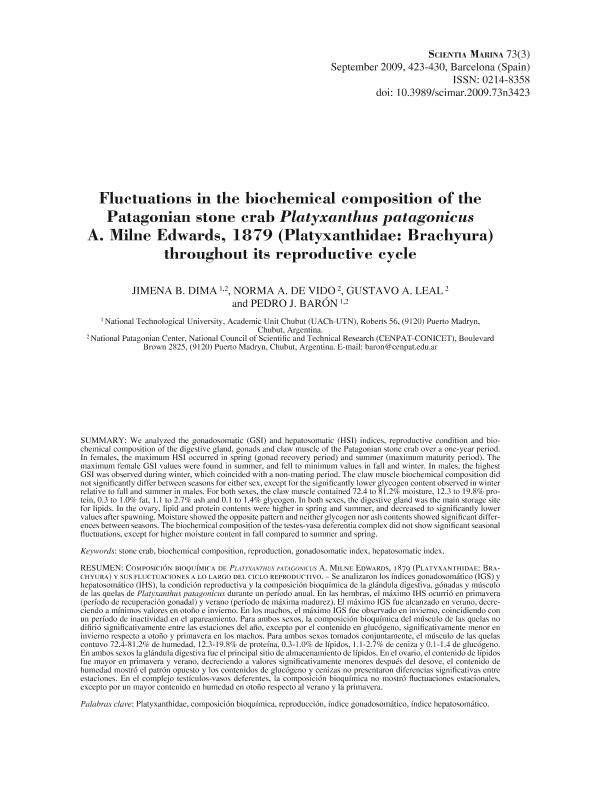Mostrar el registro sencillo del ítem
dc.contributor.author
Dima, Jimena Bernadette

dc.contributor.author
de Vido, Norma Alicia

dc.contributor.author
Leal, Gustavo Adolfo

dc.contributor.author
Baron, Pedro Jose

dc.date.available
2020-01-21T14:38:08Z
dc.date.issued
2009-12
dc.identifier.citation
Dima, Jimena Bernadette; de Vido, Norma Alicia; Leal, Gustavo Adolfo; Baron, Pedro Jose; Fluctuations in the biochemical composition of the Patagonian stone crab Platyxanthus patagonicus A. Milne Edwards, 1879 (Platyxanthidae: Brachyura) throughout its reproductive cycle; Instituto de Ciencias del Mar Barcelona; Scientia Marina; 73; 3; 12-2009; 423-430
dc.identifier.issn
1886-8134
dc.identifier.uri
http://hdl.handle.net/11336/95385
dc.description.abstract
Se analizaron los índices gonadosomático (IGS) y hepatosomático (IHS), la condición reproductiva y la composición bioquímica de la glándula digestiva, gónadas y músculo de las quelas de Platyxanthus patagonicus durante un período anual. En las hembras, el máximo IHS ocurrió en primavera (período de recuperación gonadal) y verano (período de máxima madurez). El máximo IGS fue alcanzado en verano, decreciendo a mínimos valores en otoño e invierno. En los machos, el máximo IGS fue observado en invierno, coincidiendo con un período de inactividad en el apareamiento. Para ambos sexos, la composición bioquímica del músculo de las quelas no difirió significativamente entre las estaciones del año, excepto por el contenido en glucógeno, significativamente menor en invierno respecto a otoño y primavera en los machos. Para ambos sexos tomados conjuntamente, el músculo de las quelas contuvo 72.4-81.2% de humedad, 12.3-19.8% de proteína, 0.3-1.0% de lípidos, 1.1-2.7% de ceniza y 0.1-1.4 de glucógeno. En ambos sexos la glándula digestiva fue el principal sitio de almacenamiento de lípidos. En el ovario, el contenido de lípidos fue mayor en primavera y verano, decreciendo a valores significativamente menores después del desove, el contenido de humedad mostró el patrón opuesto y los contenidos de glucógeno y cenizas no presentaron diferencias significativas entre estaciones. En el complejo testículos-vasos deferentes, la composición bioquímica no mostró fluctuaciones estacionales, excepto por un mayor contenido en humedad en otoño respecto al verano y la primavera.
dc.description.abstract
We analyzed the gonadosomatic (GSI) and hepatosomatic (HSI) indices, reproductive condition and biochemical composition of the digestive gland, gonads and claw muscle of the Patagonian stone crab over a one-year period. In females, the maximum HSI occurred in spring (gonad recovery period) and summer (maximum maturity period). The maximum female GSI values were found in summer, and fell to minimum values in fall and winter. In males, the highest GSI was observed during winter, which coincided with a non-mating period. The claw muscle biochemical composition did not significantly differ between seasons for either sex, except for the significantly lower glycogen content observed in winter relative to fall and summer in males. For both sexes, the claw muscle contained 72.4 to 81.2% moisture, 12.3 to 19.8% protein, 0.3 to 1.0% fat, 1.1 to 2.7% ash and 0.1 to 1.4% glycogen. In both sexes, the digestive gland was the main storage site for lipids. In the ovary, lipid and protein contents were higher in spring and summer, and decreased to significantly lower values after spawning. Moisture showed the opposite pattern and neither glycogen nor ash contents showed significant differences between seasons. The biochemical composition of the testes-vasa deferentia complex did not show significant seasonal fluctuations, except for higher moisture content in fall compared to summer and spring.
dc.format
application/pdf
dc.language.iso
eng
dc.publisher
Instituto de Ciencias del Mar Barcelona

dc.rights
info:eu-repo/semantics/openAccess
dc.rights.uri
https://creativecommons.org/licenses/by-nc-sa/2.5/ar/
dc.subject
BIOCHEMICAL COMPOSITION
dc.subject
GONADOSOMATIC INDEX
dc.subject
HEPATOSOMATIC INDEX
dc.subject
REPRODUCTION
dc.subject
STONE CRAB
dc.subject.classification
Alimentos y Bebidas

dc.subject.classification
Otras Ingenierías y Tecnologías

dc.subject.classification
INGENIERÍAS Y TECNOLOGÍAS

dc.title
Fluctuations in the biochemical composition of the Patagonian stone crab Platyxanthus patagonicus A. Milne Edwards, 1879 (Platyxanthidae: Brachyura) throughout its reproductive cycle
dc.title
Composición bioquímica de Platyxanthus patagonicus A. Milne Edwards, 1879 (Platyxanthidae: Brachyura) y sus fluctuaciones a lo largo del ciclo reproductivo
dc.type
info:eu-repo/semantics/article
dc.type
info:ar-repo/semantics/artículo
dc.type
info:eu-repo/semantics/publishedVersion
dc.date.updated
2019-11-25T18:04:45Z
dc.journal.volume
73
dc.journal.number
3
dc.journal.pagination
423-430
dc.journal.pais
España

dc.journal.ciudad
Barcelona
dc.description.fil
Fil: Dima, Jimena Bernadette. Universidad Tecnológica Nacional; Argentina. Consejo Nacional de Investigaciones Científicas y Técnicas. Centro Nacional Patagónico; Argentina
dc.description.fil
Fil: de Vido, Norma Alicia. Consejo Nacional de Investigaciones Científicas y Técnicas. Centro Nacional Patagónico; Argentina
dc.description.fil
Fil: Leal, Gustavo Adolfo. Consejo Nacional de Investigaciones Científicas y Técnicas. Centro Nacional Patagónico; Argentina
dc.description.fil
Fil: Baron, Pedro Jose. Universidad Tecnológica Nacional; Argentina. Consejo Nacional de Investigaciones Científicas y Técnicas. Centro Nacional Patagónico; Argentina
dc.journal.title
Scientia Marina

dc.relation.alternativeid
info:eu-repo/semantics/altIdentifier/doi/http://dx.doi.org/10.3989/scimar.2009.73n3423
dc.relation.alternativeid
info:eu-repo/semantics/altIdentifier/url/http://scientiamarina.revistas.csic.es/index.php/scientiamarina/article/view/1073
Archivos asociados
